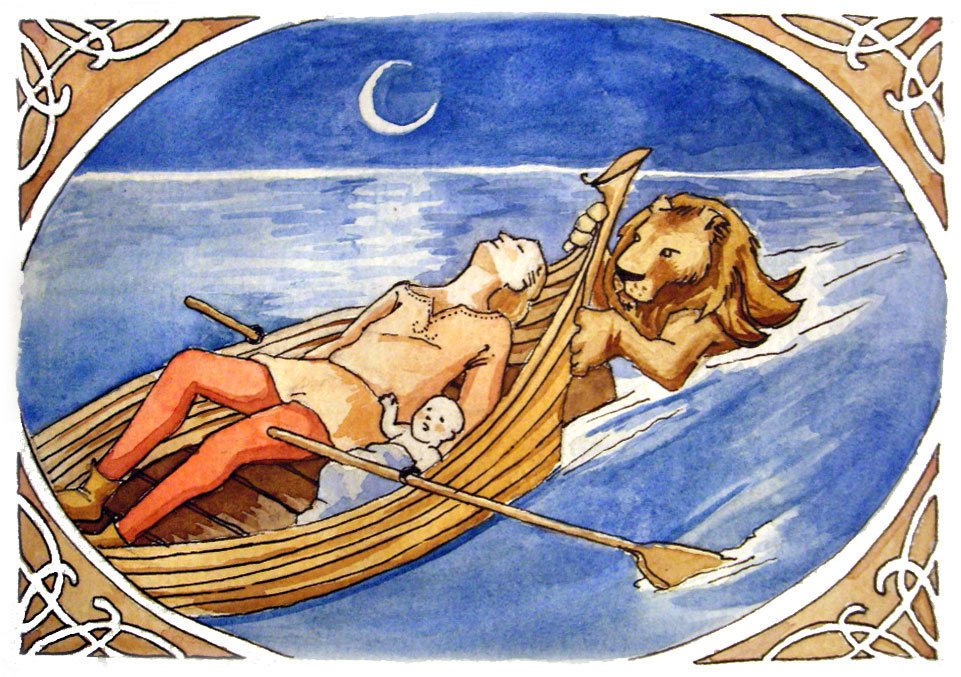By Petraverd
Introduction
Well, welcome to the second edition of my decidedly-monthly article, Character Connections! Thanks to all of you for your encouragement, and special thanks to Spear and Anastasia for their help with suggestions, and of course to Kristi for not only letting me do this and giving me a few ideas herself, but also doing the wonderful paintings for these! So, without further ado, let’s explore the similarities of two more characters. For this month, I’m going to talk about Shasta (or Cor, as we must now call him…but I’m gonna stick with Shasta, hopefully he’ll forgive me) and Moses. (As a side note, I’ve actually used a few direct Biblical quotes in this one! All quotes come from the NIV version.)
Of Boats and Baskets
Last time, when we explored the connections between Reepicheep and Elijah, there were a number of parallels at the end of their stories. With Shasta and Moses, the opposite is true. Quite a few parallels arise towards the beginning of their lives. Moses, for his own protection, was sent down the river in a little basket-like boat by his mother. Shasta was also sent out to sea as a little baby, though most definitely NOT for his own protection.
As the two float across the water, both are also watched by someone to make sure nothing happens to them: Miriam keeps an eye on her baby brother Moses, while a nameless soldier fills the same role for Shasta.
There is also an interesting detail worth speaking about with this similarity. Pauline Baynes, the illustrator for the Chronicles, details this scene with a series of drawings. In the first few, Shasta is seen in your normal, average, everyday boat…up until the moment Arsheesh discovers him. There, Shasta is depicted in a suspiciously basket-looking boat…perhaps Baynes had Moses in mind when illustrating this part of the book?
The Nature of God
Both also have an amazing experience in which they meet God, or Aslan in Shasta’s case. But this meeting is not the only similarity in the scene. During Moses’s experience with the burning bush, as detailed in Exodus 3, Moses wonders, “Suppose I go to the Israelites and say to them, ‘The God of your fathers has sent me to you,’ and they ask me, ‘What is his name?’ Then what shall I tell them?” God responds to this question by saying, “I am who I am.” This scene is echoed somewhat in The Horse and His Boy. When Shasta asks Aslan who he is, Aslan merely replies and repeats, “Myself,” first very deep, then loud and clear, then barely a whisper. While neither really gets a direct name, both get in answer a demonstration of power, a glimpse into not just who he is speaking to, but WHAT he’s speaking to, the very nature of God (or Aslan) Himself.
Send Someone Else
Another similarity creeps up in Moses’s conversation with God at the burning bush, where he says, “O Lord, please send someone else to do it.” (Exodus 4:13) Shasta also echoes this statement when he says to King Lune, after Lune tells him he is to be the next king, “But I don’t want it,” and later, “I don’t want to at all.” Both were destined, no, CHOSEN, to be great leaders, but neither really wanted it. Interestingly, both have a brother that they would prefer to take their duties as well – Moses had Aaron, and Shasta had Corin. But once they accept their leadership role, both delivered their people from a great threat.
Destinations and Foreigners
Finally, there are a few more similarities that may seem to be obvious, but I didn’t realize them until someone actually said something…good grief, I’m slipping. Anyway, both had a destination they needed to get to, and had to cross a desert to get there. Moses was the one to lead the Israelites to the Promised Land, while Shasta wanted to escape to “Narnia and the North!” Also of note is the fact that neither actually stayed where the
y had planned to after crossing the desert. Though there is a bit of difference – Moses never actually enters the Promised Land (Deuteronomy tells us he died in Moab), while Shasta does enter Narnia (though he doesn’t stay there) – I still think it’s worth taking a look at. Interestingly, foreigners also play a large role in their lives. Not only are both raised by a foreign single parent, but each also married a foreign woman: Moses married Zipporah from Midian, and Shasta eventually takes Aravis as his queen, who comes from Calormen.
Crowns: Lost and Found
Neither Shasta nor Moses turned out to be who they thought they were. However, there is a difference that arises here. Moses was raised as a prince in Egypt, but when it came time for him to lead the Israelites, he had to put that all aside, for that is not what he truly was. Shasta, on the other hand, was raised by Arsheesh as a poor boy, almost sold into slavery. But he turned out to be not only a prince, but the prince who was heir to the throne of Archenland.
In Conclusion
Well, there you have it – a look into the similar lives of Shasta and Moses. And I end with a repeat of the statement I made at the beginning of my last article: that the Chronicles are NOT allegories, and that not everything in Shasta and Moses’s lives are going to be comparable. But even so, there are enough resemblances to wonder at the possibility that Lewis had Moses in mind when writing Shasta’s story. And that’s something for you all to think about until next time…when I shall leave you all wondering about another pair of characters.




